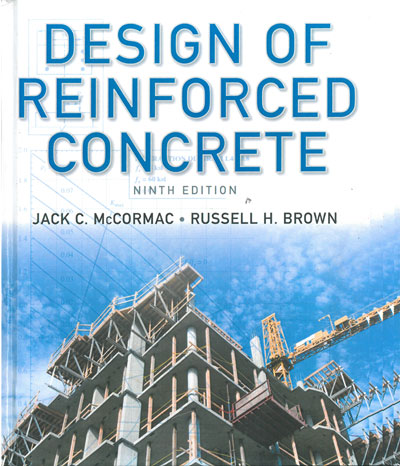Preface
Audience
This textbook presents an introduction to reinforced concrete design. We authors hope the
material is written in such a manner as to interest students in the subject and to encourage
them to continue its study in the years to come. The text was prepared with an introductory
three-credit course in mind, but sufficient material is included for an additional three-credit
course.
New to This Edition
Updated Code
With the ninth edition of this text, the contents have been updated to conform to the 2011
Building Code of the American Concrete Institute (ACI 318-11). Changes to this edition of the
code include:
• Factored load combinations are now based on ASCE/SEI 7-10, which now treats wind
as a strength level load.
• Minor revisions to development length to headed bars.
• Addition of minimum reinforcement provisions to deep beams.
• Introduction of Grade 80 deformed bars in accordance with ASTM 615 and ASTM 706.
• Zinc and epoxy dual-coated reinforcing bars are now permitted in accordance with ASTM
A1055.
New Chapter on Concrete Masonry
A new chapter on strength design of reinforced concrete masonry has been added to replace the
previous Chapter 20 on formwork. Surveys revealed that the forms chapter was not being used
and that a chapter on masonry would be more valuable. Because strength design of reinforced
concrete masonry is so similar to that of reinforced concrete, the authors felt that this would be
a logical extension to the application of the theories developed earlier in the text. The design
of masonry lintels, walls loaded out-of-plane, and shear walls are included. The subject of this
chapter could easily occupy an entire textbook, so this chapter is limited in scope to only the
basics. An example of the design of each type of masonry element is also included to show
the student some typical applications.
Units Added to Example Problems
The example problems now have units associated with the input values. This will assist the
student in determining the source of each input value as well as help in the use of dimensional
analysis in determining the correct answers and the units of the answers. Often the student
can catch errors in calculations simply by checking the dimensions of the calculated answer
against what the units are known to be.
Organization
The text is written in the order that the authors feel would follow the normal sequence of
presentation for an introductory course in reinforced concrete design. In this way, it is hoped
that skipping back and forth from chapter to chapter will be minimized. The material on
columns is included in three chapters (Chapters 9, 10, and 11). Some instructors do not have
time to cover the material on slender columns, so it was put in a separate chapter (Chapter
11). The remaining material on columns was separated into two chapters in order to emphasize
the difference between columns that are primarily axially loaded (Chapter 9) and those with
significant bending moment combined with axial load (Chapter 10). The material formerly in
Chapter 21, “Seismic Design of Concrete Structures,” has been updated and moved to a new
appendix (Appendix D).
Instructor and Student Resources
The website for the book is located at www.wiley.com/college/mccormac and contains the
following resources.
For Instructors
Solutions Manual A password-protected Solutions Manual, which contains complete solutions
for all homework problems in the text, is available for download. Most are handwritten,
but some are carried out using spreadsheets or Mathcad.
Figures in PPT Format Also available are the figures from the text in PowerPoint format,
for easy creation of lecture slides.
Lecture Presentation Slides in PPT Format Presentation slides developed by Dr. Terry
Weigel of the University of Louisville are available for instructors who prefer to use PowerPoint
for their lectures. The PowerPoint files are posted rather than files in PDF format to permit the
instructor to modify them as appropriate for his or her class.
Sample Exams Examples of sample exams are included for most topics in the text. Problems
in the back of each chapter are also suitable for exam questions.
Course Syllabus A course syllabus along with a typical daily schedule are included in
editable format.
Visit the Instructor Companion Site portion of the book website at www.wiley.com/
college/mccormac to register for a password. These resources are available for instructors
who have adopted the book for their course. The website may be updated periodically with
additional material.
For Students and Instructors
Excel Spreadsheets Excel spreadsheets were created to provide the student and the instructor
with tools to analyze and design reinforced concrete elements quickly to compare alternative
solutions. Spreadsheets are provided for most chapters of the text, and their use is selfexplanatory.
Many of the cells contain comments to assist the new user. The spreadsheets
can be modified by the student or instructor to suit their more specific needs. In most cases,
calculations contained within the spreadsheets mirror those shown in the example problems
in the text. The many uses of these spreadsheets are illustrated throughout the text. At the
end of most chapters are example problems demonstrating the use of the spreadsheet for that
particular chapter. Space does not permit examples for all of the spreadsheet capabilities. The
examples chosen were thought by the authors to be the most relevant.
Visit the Student Companion Site portion of the book website at www.wiley.com/
college/mccormac to download this software.
Acknowledgments
We wish to thank the following people who reviewed this edition:
Madasamy Arockiasamy, Florida Atlantic University
Pinaki R. Chakrabarti, California State University, Fullerton
Wonchang Choi, North Carolina A&T State University
Apostolos Fafitis, Arizona State University
Farhad Reza, Minnesota State University
Rudolf Seracino, North Carolina State University
Brian Swartz, University of Hartford
Xi Xu, Stevens Institute of Technology
Finally, we are also grateful to the reviewers and users of the previous editions of this
book for their suggestions, corrections, and criticisms. We are always grateful to anyone who
takes the time to contact us concerning any part of the book.
Jack C.McCormac
Russell H. Brown
Contents
Preface xv
1 Introduction 1
1.1 Concrete and Reinforced Concrete, 1
1.2 Advantages of Reinforced Concrete as a Structural Material, 1
1.3 Disadvantages of Reinforced Concrete as a Structural Material, 2
1.4 Historical Background, 3
1.5 Comparison of Reinforced Concrete and Structural Steel for Buildings and Bridges, 5
1.6 Compatibility of Concrete and Steel, 6
1.7 Design Codes, 6
1.8 SI Units and Shaded Areas, 7
1.9 Types of Portland Cement, 7
1.10 Admixtures, 9
1.11 Properties of Concrete, 10
1.12 Aggregates, 18
1.13 High-Strength Concretes, 19
1.14 Fiber-Reinforced Concretes, 20
1.15 Concrete Durability, 21
1.16 Reinforcing Steel, 22
1.17 Grades of Reinforcing Steel, 24
1.18 SI Bar Sizes and Material Strengths, 25
1.19 Corrosive Environments, 26
1.20 Identifying Marks on Reinforcing Bars, 26
1.21 Introduction to Loads, 28
1.22 Dead Loads, 28
1.23 Live Loads, 29
1.24 Environmental Loads, 30
1.25 Selection of Design Loads, 32
1.26 Calculation Accuracy, 33
1.27 Impact of Computers on Reinforced Concrete Design, 34
Problems, 34
2 Flexural Analysis of Beams 35
2.1 Introduction, 35
2.2 Cracking Moment, 38
2.3 Elastic Stresses—Concrete Cracked, 41
2.4 Ultimate or Nominal Flexural Moments, 48
2.5 SI Example, 51
2.6 Computer Examples, 52
Problems, 54
3 Strength Analysis of Beams According to ACI Code 65
3.1 Design Methods, 65
3.2 Advantages of Strength Design, 66
3.3 Structural Safety, 66
3.4 Derivation of Beam Expressions, 67
3.5 Strains in Flexural Members, 70
3.6 Balanced Sections, Tension-Controlled Sections, and Compression-Controlled or Brittle Sections, 71
3.7 Strength Reduction or ö Factors, 71
3.8 Minimum Percentage of Steel, 74
3.9 Balanced Steel Percentage, 75
3.10 Example Problems, 76
3.11 Computer Examples, 79
Problems, 80
4 Design of Rectangular Beams and One-Way Slabs 82
4.1 Load Factors, 82
4.2 Design of Rectangular Beams, 85
4.3 Beam Design Examples, 89
4.4 Miscellaneous Beam Considerations, 95
4.5 Determining Steel Area When Beam Dimensions Are Predetermined, 96
4.6 Bundled Bars, 98
4.7 One-Way Slabs, 99
4.8 Cantilever Beams and Continuous Beams, 102
4.9 SI Example, 103
4.10 Computer Example, 105
Problems, 106
5 Analysis and Design of T Beams and Doubly Reinforced Beams 112
5.1 T Beams, 112
5.2 Analysis of T Beams, 114
5.3 Another Method for Analyzing T Beams, 118
5.4 Design of T Beams, 120
5.5 Design of T Beams for Negative Moments, 125
5.6 L-Shaped Beams, 127
5.7 Compression Steel, 127
5.8 Design of Doubly Reinforced Beams, 132
5.9 SI Examples, 136
5.10 Computer Examples, 138
Problems, 143
6 Serviceability 154
6.1 Introduction, 154
6.2 Importance of Deflections, 154
6.3 Control of Deflections, 155
6.4 Calculation of Deflections, 157
6.5 Effective Moments of Inertia, 158
6.6 Long-Term Deflections, 160
6.7 Simple-Beam Deflections, 162
6.8 Continuous-Beam Deflections, 164
6.9 Types of Cracks, 170
6.10 Control of Flexural Cracks, 171
6.11 ACI Code Provisions Concerning Cracks, 175
6.12 Miscellaneous Cracks, 176
6.13 SI Example, 176
6.14 Computer Example, 177
Problems, 179
7 Bond, Development Lengths, and Splices 184
7.1 Cutting Off or Bending Bars, 184
7.2 Bond Stresses, 187
7.3 Development Lengths for Tension Reinforcing, 189
7.4 Development Lengths for Bundled Bars, 197
7.5 Hooks, 199
7.6 Development Lengths for Welded Wire Fabric in Tension, 203
7.7 Development Lengths for Compression Bars, 204
7.8 Critical Sections for Development Length, 206
7.9 Effect of Combined Shear and Moment on Development Lengths, 206
7.10 Effect of Shape of Moment Diagram on Development Lengths, 207
7.11 Cutting Off or Bending Bars (Continued), 208
7.12 Bar Splices in Flexural Members, 211
7.13 Tension Splices, 213
7.14 Compression Splices, 213
7.15 Headed and Mechanically Anchored Bars, 214
7.16 SI Example, 215
7.17 Computer Example, 216
Problems, 217
8 Shear and Diagonal Tension 223
8.1 Introduction, 223
8.2 Shear Stresses in Concrete Beams, 223
8.3 Lightweight Concrete, 224
8.4 Shear Strength of Concrete, 225
8.5 Shear Cracking of Reinforced Concrete Beams, 226
8.6 Web Reinforcement, 227
8.7 Behavior of Beams with Web Reinforcement, 229
8.8 Design for Shear, 231
8.9 ACI Code Requirements, 232
8.10 Shear Design Example Problems, 237
8.11 Economical Spacing of Stirrups, 247
8.12 Shear Friction and Corbels, 249
8.13 Shear Strength of Members Subjected to Axial Forces, 251
8.14 Shear Design Provisions for Deep Beams, 253
8.15 Introductory Comments on Torsion, 254
8.16 SI Example, 256
8.17 Computer Example, 257
Problems, 258
9 Introduction to Columns 263
9.1 General, 263
9.2 Types of Columns, 264
9.3 Axial Load Capacity of Columns, 266
9.4 Failure of Tied and Spiral Columns, 266
9.5 Code Requirements for Cast-in-Place Columns, 269
9.6 Safety Provisions for Columns, 271
9.7 Design Formulas, 272
9.8 Comments on Economical Column Design, 273
9.9 Design of Axially Loaded Columns, 274
9.10 SI Example, 277
9.11 Computer Example, 278
Problems, 279
10 Design of Short Columns Subject to Axial Load and Bending 281
10.1 Axial Load and Bending, 281
10.2 The Plastic Centroid, 282
10.3 Development of Interaction Diagrams, 284
10.4 Use of Interaction Diagrams, 290
10.5 Code Modifications of Column Interaction Diagrams, 292
10.6 Design and Analysis of Eccentrically Loaded Columns Using Interaction Diagrams, 294
10.7 Shear in Columns, 301
10.8 Biaxial Bending, 302
10.9 Design of Biaxially Loaded Columns, 306
10.10 Continued Discussion of Capacity Reduction Factors, ö, 309
10.11 Computer Example, 311
Problems, 312
11 Slender Columns 317
11.1 Introduction, 317
11.2 Nonsway and Sway Frames, 317
11.3 Slenderness Effects, 318
11.4 Determining k Factors with Alignment Charts, 321
11.5 Determining k Factors with Equations, 322
11.6 First-Order Analyses Using Special Member Properties, 323
11.7 Slender Columns in Nonsway and Sway Frames, 324
11.8 ACI Code Treatments of Slenderness Effects, 328
11.9 Magnification of Column Moments in Nonsway Frames, 328
11.10 Magnification of Column Moments in Sway Frames, 333
11.11 Analysis of Sway Frames, 336
11.12 Computer Examples, 342
Problems, 344
12 Footings 347
12.1 Introduction, 347
12.2 Types of Footings, 347
12.3 Actual Soil Pressures, 350
12.4 Allowable Soil Pressures, 351
12.5 Design of Wall Footings, 352
12.6 Design of Square Isolated Footings, 357
12.7 Footings Supporting Round or Regular Polygon-Shaped Columns, 364
12.8 Load Transfer from Columns to Footings, 364
12.9 Rectangular Isolated Footings, 369
12.10 Combined Footings, 372
12.11 Footing Design for Equal Settlements, 378
12.12 Footings Subjected to Axial Loads and Moments, 380
12.13 Transfer of Horizontal Forces, 382
12.14 Plain Concrete Footings, 383
12.15 SI Example, 386
12.16 Computer Examples, 388
Problems, 391
13 Retaining Walls 394
13.1 Introduction, 394
13.2 Types of Retaining Walls, 394
13.3 Drainage, 397
13.4 Failures of Retaining Walls, 398
13.5 Lateral Pressure on Retaining Walls, 399
13.6 Footing Soil Pressures, 404
13.7 Design of Semigravity Retaining Walls, 405
13.8 Effect of Surcharge, 408
13.9 Estimating the Sizes of Cantilever Retaining Walls, 409
13.10 Design Procedure for Cantilever Retaining Walls, 413
13.11 Cracks and Wall Joints, 424
Problems, 426
14 Continuous Reinforced Concrete Structures 431
14.1 Introduction, 431
14.2 General Discussion of Analysis Methods, 431
14.3 Qualitative Influence Lines, 431
14.4 Limit Design, 434
14.5 Limit Design under the ACI Code, 442
14.6 Preliminary Design of Members, 445
14.7 Approximate Analysis of Continuous Frames for Vertical Loads, 445
14.8 Approximate Analysis of Continuous Frames for Lateral Loads, 454
14.9 Computer Analysis of Building Frames, 458
14.10 Lateral Bracing for Buildings, 459
14.11 Development Length Requirements for Continuous Members, 459
Problems, 465
15 Torsion 470
15.1 Introduction, 470
15.2 Torsional Reinforcing, 471
15.3 Torsional Moments that Have to Be Considered in Design, 474
15.4 Torsional Stresses, 475
15.5 When Torsional Reinforcing Is Required by the ACI, 476
15.6 Torsional Moment Strength, 477
15.7 Design of Torsional Reinforcing, 478
15.8 Additional ACI Requirements, 479
15.9 Example Problems Using U.S. Customary Units, 480
15.10 SI Equations and Example Problem, 483
15.11 Computer Example, 487
Problems, 488
16 Two-Way Slabs, Direct Design Method 492
16.1 Introduction, 492
16.2 Analysis of Two-Way Slabs, 495
16.3 Design of Two-Way Slabs by the ACI Code, 495
16.4 Column and Middle Strips, 496
16.5 Shear Resistance of Slabs, 497
16.6 Depth Limitations and Stiffness Requirements, 500
16.7 Limitations of Direct Design Method, 505
16.8 Distribution of Moments in Slabs, 506
16.9 Design of an Interior Flat Plate, 511
16.10 Placing of Live Loads, 514
16.11 Analysis of Two-Way Slabs with Beams, 517
16.12 Transfer of Moments and Shears between Slabs and Columns, 522
16.13 Openings in Slab Systems, 528
16.14 Computer Example, 528
Problems, 530
17 Two-Way Slabs, Equivalent Frame Method 532
17.1 Moment Distribution for Nonprismatic Members, 532
17.2 Introduction to the Equivalent Frame Method, 533
17.3 Properties of Slab Beams, 535
17.4 Properties of Columns, 538
17.5 Example Problem, 540
17.6 Computer Analysis, 544
17.7 Computer Example, 545
Problems, 546
18 Walls 547
18.1 Introduction, 547
18.2 Non–Load-Bearing Walls, 547
18.3 Load-Bearing Concrete Walls—Empirical Design Method, 549
18.4 Load-Bearing Concrete Walls—Rational Design, 552
18.5 Shear Walls, 554
18.6 ACI Provisions for Shear Walls, 558
18.7 Economy in Wall Construction, 563
18.8 Computer Example, 564
Problems, 565
19 Prestressed Concrete 567
19.1 Introduction, 567
19.2 Advantages and Disadvantages of Prestressed Concrete, 569
19.3 Pretensioning and Posttensioning, 569
19.4 Materials Used for Prestressed Concrete, 570
19.5 Stress Calculations, 572
19.6 Shapes of Prestressed Sections, 576
19.7 Prestress Losses, 579
19.8 Ultimate Strength of Prestressed Sections, 582
19.9 Deflections, 586
19.10 Shear in Prestressed Sections, 590
19.11 Design of Shear Reinforcement, 591
19.12 Additional Topics, 595
19.13 Computer Example, 597
Problems, 598
20 Reinforced Concrete Masonry 602
20.1 Introduction, 602
20.2 Masonry Materials, 602
20.3 Specified Compressive Strength of Masonry, 606
20.4 Maximum Flexural Tensile Reinforcement, 607
20.5 Walls with Out-of-Plane Loads—Non–Load-Bearing Walls, 607
20.6 Masonry Lintels, 611
20.7 Walls with Out-of-Plane Loads—Load-Bearing, 616
20.8 Walls with In-Plane Loading—Shear Walls, 623
20.9 Computer Example, 628
Problems, 630
A Tables and Graphs: U.S. Customary Units 631
B Tables in SI Units 669
C The Strut-and-Tie Method of Design 675
C.1 Introduction, 675
C.2 Deep Beams, 675
C.3 Shear Span and Behavior Regions, 675
C.4 Truss Analogy, 677
C.5 Definitions, 678
C.6 ACI Code Requirements for Strut-and-Tie Design, 678
C.7 Selecting a Truss Model, 679
C.8 Angles of Struts in Truss Models, 681
C.9 Design Procedure, 682
D Seismic Design of Reinforced Concrete Structures 683
D.1 Introduction, 683
D.2 Maximum Considered Earthquake, 684
D.3 Soil Site Class, 684
D.4 Risk and Importance Factors, 686
D.5 Seismic Design Categories, 687
D.6 Seismic Design Loads, 687
D.7 Detailing Requirements for Different Classes of Reinforced Concrete Moment Frames, 691
Problems, 698
Glossary 699
Index 703











